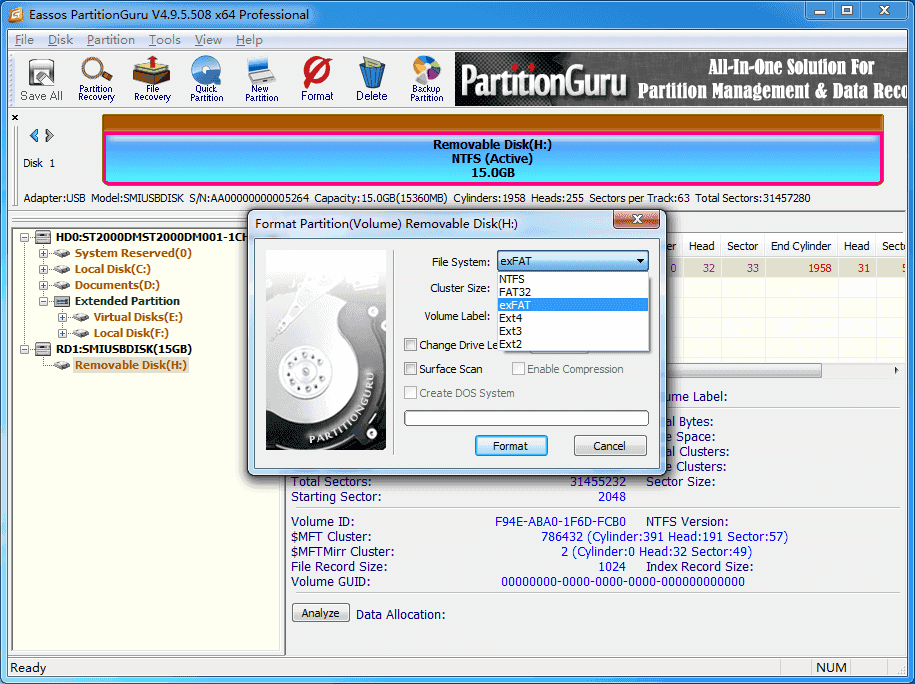

- #External hard drive format for mac and windows how to
- #External hard drive format for mac and windows install
- #External hard drive format for mac and windows portable
- #External hard drive format for mac and windows plus
- #External hard drive format for mac and windows windows
▪ select partition m, where “m” is the WD hard drive partition number ▪ select disk n, where “n” is the number of the WD hard drive In Diskpart window, input the following commands and every command shall come with pressing Enter key. “Enter” to run Diskpart utility as administrator.Ģ.
#External hard drive format for mac and windows windows
Press “ Windows + R” simultaneously, input “diskpart” in the pop-up box, and hit However, in File Explorer, if you right-click partition on the WD hard drive andĬhoose “Format”, you’ll find that there is no exFAT option.Īt this time, you can format WD hard drive to exFAT via Diskpart. The first tool that occurs to your mind to format WD hard drive might be File Explorer. Warning: Format will erase all data on the partition of WD hard drive therefore you need to back up your important data at first. Here are two ways offered and you can choose based on your own situation.
#External hard drive format for mac and windows how to
Two ways for reformatting WD hard drive for Mac and PCĪfter realizing that you can reformat WD hard drive to FAT32 or exFAT to make it compatible with Mac OS X and still can be used under Windows, it is time to check out how to reformat WD hard drive for Mac and PC in Windows successfully. And if there is a large file beyond 4GB in file size, exFAT file system will be the better choice as FAT32 is with file size limit. Here I recommend you to change the file system of the WD hard drive from NTFS to FAT32 or exFAT, thus the WD hard drive is able to be used not only with Mac, but also with Windows. Mac OS X is able to support HFS+, FAT32 and exFAT drives and Windows can support NTFS, FAT32 and exFAT. In such a case, it’s necessary to reformat WD hard drive to make it compatible with Mac operating system. If you connect your WD hard drive without reformatting, you’ll be unable to copy files to the disk as Mac read only supports NTFS file system. I wonder whether I can just use it with Mac directly or need to reformat it for Mac? If the WD Elements drive needs reformating for Mac? If it is necessary to reformat the hard drive, what kind of file system should I reformat it as? Can I format it for Mac on PC? Need to reformat WD hard drive for Mac Now, I need to use it with my Mac to save some files.

#External hard drive format for mac and windows portable
“I have a 1TB WD Elements Portable USB 3.0 hard drive, formatted with NTFS and used with PC running Windows 10.
#External hard drive format for mac and windows install
Alternatively, you can install a program like Microsoft’s NTFS software from Paragon (paid app) or the open source Tuxera (free) on your Mac to enable the NTFS read / write support, but, even with third-party options, some features, including Time Machine, will not work properly with an NTFS file system.Can I reformat WD hard drive for Mac on PC? Here’s how to partition a hard drive for use on Windows and Mac. You can check our Windows section for more information on this process. If you are concerned about the reliability factor of the exFAT file system, or the lack of it, there is a way to format the secondary Windows partition to NTFS, but it requires connecting the hard drive to a Windows computer. Note that you will see icons on the desktop for both units. Click the Partition button in an additional pop-up window to complete the process. Enter a volume name, select the exFAT format, and click the Apply button. A second part appears, cutting the pie chart in half.
#External hard drive format for mac and windows plus
On the next screen, click the little plus ( + ) button below the blue pie chart to add a second partition. Select the drive again in Disk Utility and click Partition. After completing this procedure, your disk should have only one partition. Click the Delete button to make these changes. In the next pop-up window, select a profile, in this case MacOS Extended (Journaled) for Format, and GUID Partition Map for Scheme or Partition Type. Click Delete, located on the top toolbar of the application. With Disk Utility open, in the Location option, your drive appears in External on the left. Double-click the Disk Utility icon in the next window. With Finder highlighted, click Go in the menu bar followed by Utilities in the drop-down menu. If the error does not appear, start with step 1. Like Windows 10, you may see an “initialization” error because the drive’s file system is not “readable.” Click the Initialize button in the small pop-up screen to create the first compatible partition, and then start at step 5. If you already have a Mac compatible partition, continue from step 5. Partitioning an external disk in MacOS is not that annoying, initially, we will assume that it does not have partitions, so we will need to create two.


 0 kommentar(er)
0 kommentar(er)
